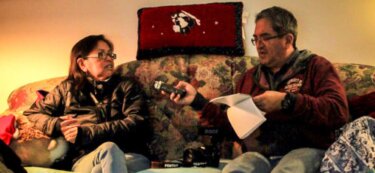Reconciling journalism
One year ago, the Truth and Reconciliation Commission called on the journalism industry to confront its contribution to the Canadian public’s ignorance and misconceptions of Indigenous peoples and issues. Toward Reconciliation is our response to that chal

On Jan. 22, 2016, four people ― two teenagers and two high school teachers ― were killed and seven injured during a shooting in the northern Dene community of La Loche, Sask. A 17-year-old suspect was charged with four counts of first degree murder and seven counts of attempted murder.
In the way Canadian media typically covers its vast hinterlands, reporters descended on the isolated town. The large contingent of journalists, mostly from mainstream outlets headquartered in the urban south, were charged with trying to make sense of the worst school shooting in Canada since 1989.
From our office in Vancouver’s Chinatown, the Discourse Media team followed the news closely. For months, we had been studying media coverage of Indigenous peoples and issues as part of our project Toward Reconciliation. We wanted to know: in the aftermath of the Truth and Reconciliation Commission (TRC), what were Canadian media outlets and journalism schools doing to address the TRC’s calls to the media industry? And were these responses improving our reporting?
A familiar narrative
As the La Loche tragedy unfolded, we watched a familiar narrative quickly take hold. “The region is predominantly young and Indigenous, and recently it has struggled with high rates of unemployment, suicide and substance abuse,” reported the Globe and Mail. The National Post called La Loche “a town without hope.” The New York Times pointed out its “bleak history.” A Maclean’s columnist argued Canadians need to “help” the people of La Loche leave the north to integrate “into one of the world’s healthiest, safest, most rewarding societies.”
“Media has a role to play in ensuring that public information both for and about Aboriginal peoples reflects their cultural diversity and provides fair and non-discriminatory reporting”
The coverage spurred criticism from people across the country, who took issue with the implication that the shooting was the result of a failed community that needed help from mainstream Canada. Nine days later, La Loche residents hit a breaking point. Arguing that they were sick of reporters misrepresenting their community, they began banning media from gatherings.
Like most of Canada’s small towns, La Loche attracts national media attention only in response to news events, usually a tragedy. And while the problems journalists highlighted in attempting to explain the brutal shooting are all too real, most missed a large part of La Loche’s story in the rush to meet daily deadlines.
In a thoughtful feature published a week after the shooting, three Globe and Mail reporters described a community of Dene with a deep commitment to their culture, their land and each other. La Loche’s struggles with unemployment, suicide and substance abuse are hardly “recent,” they found, and are related to Canada’s child welfare system and complex history of colonialism and residential school system. Yet by many measures, things are looking up; violent crime has fallen by 50 per cent in the past 10 years.
But despite this nuanced reporting, the national narrative was already set. In the public imagination, this was another sad story of a dysfunctional Indigenous community with little hope.
A history of misrepresentation of Indigenous peoples in Canadian media
Hundreds of distinct Indigenous nations exist in Canada, with unique cultures, histories and ways of life. “Yet the country’s most ubiquitous agent of public education, the newspaper, has tended to conflate all these people into one heavily stereotyped monolith, patterned on a colonial ideology that exists to this day,” argue the authors of Seeing Red: A History of Natives in Canadian Newspapers.
Mark Anderson and Carmen Robertson provide detailed evidence that, throughout history, mainstream media promoted ideas and representations of Indigenous peoples that supported “the thinking that gave rise to residential schools.”
The authors’ analysis of newspaper coverage from 1869 to 2009 found that media consistently portrayed a view of Aboriginal people as having, when compared to white people, three characteristics: “depravity, innate inferiority, and a stubborn resistance to progress.”
Answering the call
How could journalists have covered La Loche differently and better? What sort of news coverage could advance a constructive conversation about addressing the systemic challenges stemming from our troubled colonial history? These are the questions that Discourse is exploring as part of Toward Reconciliation.

One year ago, on June 2, 2015, the Truth and Reconciliation Commission (TRC) released 94 calls to action, the outcome of its six-year inquiry into Canada’s residential school system that heard from more than 6,750 witnesses.
Within this blueprint for how to redress the effects of residential schools and move Canada towards reconciliation, the TRC states, “Media has a role to play in ensuring that public information both for and about Aboriginal peoples reflects their cultural diversity and provides fair and non-discriminatory reporting… [this role] requires journalists to be well informed about the history of Aboriginal peoples and the issues that affect their lives. As we have seen, this is not necessarily the case.”
Toward Reconciliation is our response to the TRC’s challenge to our industry. The project ― a collaboration between journalists, media outlets and other organizations working to contribute to reconciliation ― aims to be a hub of high-quality, forward-looking journalism about how governments, institutions, communities and individuals are responding to the challenges of reconciliation.
On this website, we will publish investigations into how our country is changing as we attempt to revitalize relationships between Indigenous peoples and all Canadians. We will track governments’ and institutions’ pledges to change and hold them to account. We will share stories of communities and individuals who are working on solutions. In other words, we’re less concerned with covering a story like the La Loche shooting itself than we are with how an affected community is thinking about its future and moving forward.
What is reconciliation?
On June 2, 2015, the TRC released 94 calls to action detailing a roadmap for revitalizing relationships between Indigenous and non-Indigenous people in Canada. These calls — specific actions and policy changes that apply to a wide range of Canadian governments, institutions, industries and communities — were the result of a six-year inquiry into the residential school system, which the commission found was a deliberate act of “cultural genocide.” Three calls dealt specifically with the journalism sector.
At Discourse, we understand reconciliation to be about relationships and growth. We believe reconciling journalism requires going deeper than addressing inequities between Indigenous and non-Indigenous people — for example, by encouraging more Indigenous journalists or increasing the number of stories published on Indigenous issues. Those changes are conditions to reconciliation. Rather, we see reconciliation as being the process of critically rethinking the relationship between Indigenous people and the media including the values and power structures that are at the heart of how we report and why.
Read the calls to action.
Toward Reconciliation also aims to improve how Canadian media cover Indigenous peoples and issues. We don’t claim to have all the answers. And we know that our journalist colleagues, including those we criticize, are motivated by the same thing we are: a desire to contribute to positive change and a frustration that people continue to struggle with issues like unsafe drinking water, violence and crippling poverty in a wealthy place like Canada in 2016.
But we (an organization of mostly non-Aboriginal journalists) acknowledge that our industry doesn’t have the greatest track record when it comes to how we represent Indigenous perspectives.
In the words of Chelsea Vowel, author of Indigenous Writes: A Guide to First Nations, Métis & Inuit issues in Canada, "For over a century and a half, the Canadian media has failed to provide Canadians with a clear understanding of historical and contemporary contributions of Indigenous peoples, of the Treaties and other relationships between Indigenous and non-Indigenous peoples, or of the legacy of the residential school system… [media has an] obligation to engage in a concerted program of education to aid in correcting widespread ignorance and misconceptions about Indigenous peoples."Vowel wrote this in an article for Canadaland, published January 29, 2016. See her blog, âpihtawikosisân, for more of her writings on law, language and life.
We recognize a need to spark and participate in a conversation within our industry that tackles hard questions, confronts our fears of wading into such tough subject matter and gets to the heart of our values as reporters.
The story of a lifetime
A year after the TRC released its Calls to Action, there is an untapped opportunity for sustained reporting. Every media outlet in the country reported on the news event. Yet — like when the 4000-page final report of the Royal Commission on Aboriginal Peoples was released in 1996 — there has been little continued reporting on how, if at all, Canada is delivering on its pledge to address the issues raised. Toward Reconciliation exists to catalyze that kind of in-depth reporting on reconciliation.
As it turns out, reporting on reconciliation is as exciting as it is challenging ― it means taking on narratives about power, complete with plot twists, hidden agendas and unexposed data. It is a minefield of underreported stories about solutions and a dream beat for any journalist keen to speak truth to power. Prime Minister Justin Trudeau has promised to build a “nation-to-nation” relationship based on recognition. His government has adopted the United Nations Declaration on the Rights of Indigenous Peoples. These decisions have huge implications for Canada.
Our first reports include:
These stories are just a first step. We’ll be publishing further investigations in the weeks and months to come. We are purposefully participating in the conversation both online and offline. We are sharing our data and findings. We are working to ensure our reporting ends up in the hands of those best positioned to create change and hold those in positions of power accountable for their promises. We'll offer a behind-the-scenes look at the ethical challenges we’re facing and what we’re learning.
This is where you come in. We want to hear how reconciliation is playing out in your life. We want to hear your ideas for stories. What is your community or organization doing to reconcile? What solutions do you see? Who is inspiring you?
